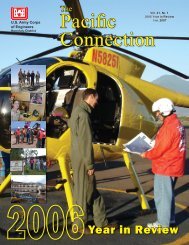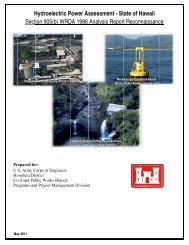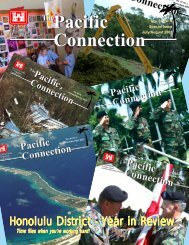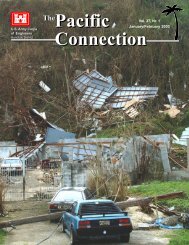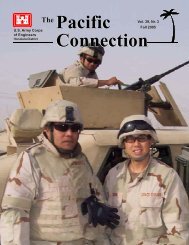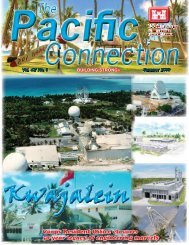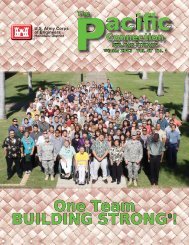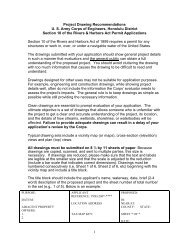The Pacific Connection - Honolulu District - U.S. Army
The Pacific Connection - Honolulu District - U.S. Army
The Pacific Connection - Honolulu District - U.S. Army
Create successful ePaper yourself
Turn your PDF publications into a flip-book with our unique Google optimized e-Paper software.
10 <strong>The</strong> <strong>Pacific</strong> <strong>Connection</strong>World War IIVolunteersWomen’s <strong>Army</strong> Volunteer Corps formed in 1942. Thisgroup of 500 HED and Hawaii Constructors femaleemployees received six weeks of special training so theycould assist the <strong>District</strong> with evacuation drills, first aidand other duties normally assigned to men.TrainingHED built a number of training centers in Hawaii during the war such as this one at Helemano. <strong>The</strong> <strong>District</strong>also built amphibious and jungle training centers as well as barracks and support facilities at a numberof bases in the <strong>Pacific</strong> including those near the airfields on the new air ferry routes.World War II MilestonesSept. 1943: <strong>The</strong> <strong>District</strong> Engineer Office and the Department Engineer merged tobecome the Engineer Office, Central <strong>Pacific</strong> Area. As the U.S. war in the <strong>Pacific</strong> shiftedfrom defense to offense, HED’s work focus changed as well.Nov. 1943: U.S. captures the Gilbert Islands. HED became responsible for trooptraining, supplying materials and equipment and reproducing intelligence maps. <strong>The</strong>campaign for the three <strong>Pacific</strong> Atolls, Gilbert, Marshall and Marianas Islandsconstituted HED’s most direct contribution to the war.May 1944: HED begins construction on Richardson Hall dubbed the “PineapplePentagon” at Ft. Shafter. This was one of HED’s most complex projects. To minimizeexcavation, HED built three irregularly-shaped structures on a steep sloping site.Aug. 1944: HED reorganizes to become the “ConstructionService” of the Central <strong>Pacific</strong> Base Command.Aug. 1944: Construction begins on Tripler <strong>Army</strong> MedicalCenter.Feb. 1945: Construction begins on HED’s new headquarters atFt. Armstrong. <strong>The</strong> project was urgent, as Punahou classes werepromised to resume in the Fall.1945: Many land transactions by Real Estate Division; schools,plantations and gas stations returned to public use.1945: Dredge material used to build up swamp land where AlaMoana Center is today. <strong>The</strong> Dredging Division used numeroushopper, electric cutterhead pipeline and clamshell dredges.Aug. 1945: HED supplied engineers materials necessary tocapture Iwo Jima and Ryukyus.Sept. 8, 1945: Punahou School returned to trustees inrestored/improved condition and new <strong>District</strong> headquartersestablished at Fort Armstrong.1944-1945: Recycled and installed big Navy guns salvagedfrom sunken U.S. warships as part of island’s defense.Military ConstructionPrioritiesWaikiki Beach in 1944 was clearly in need of beachreplenishment. During the war, many of HED’s criticalcivil works projects had to be postponed in favor ofmilitary projects.HED had thousands of ongoing military construction projects during WW II. <strong>The</strong>Construction Service was established in 1944. HED’s total war construction costswere estimated to be $400 million.




